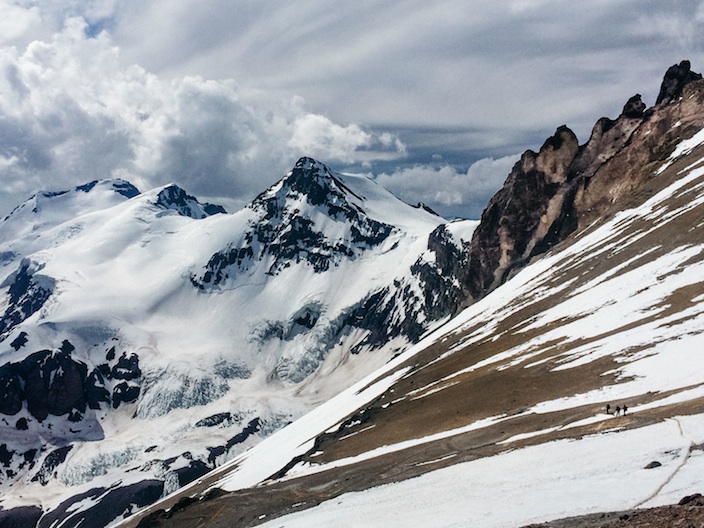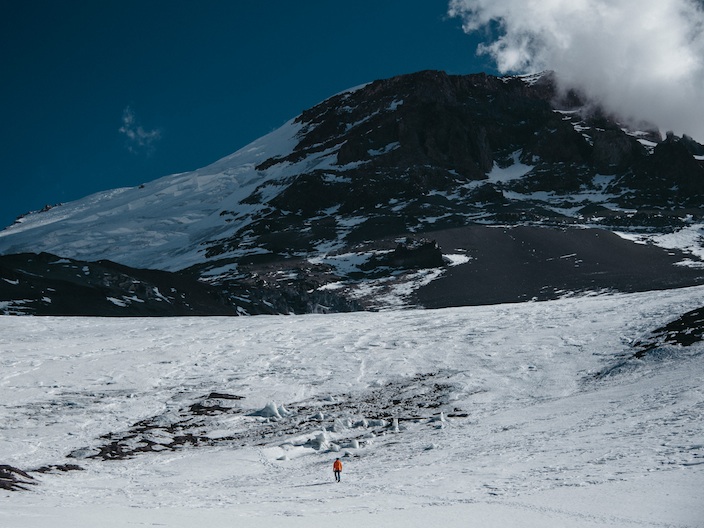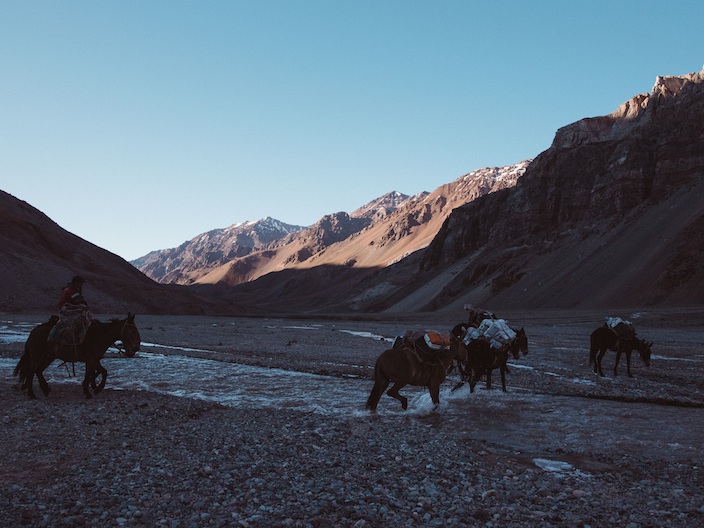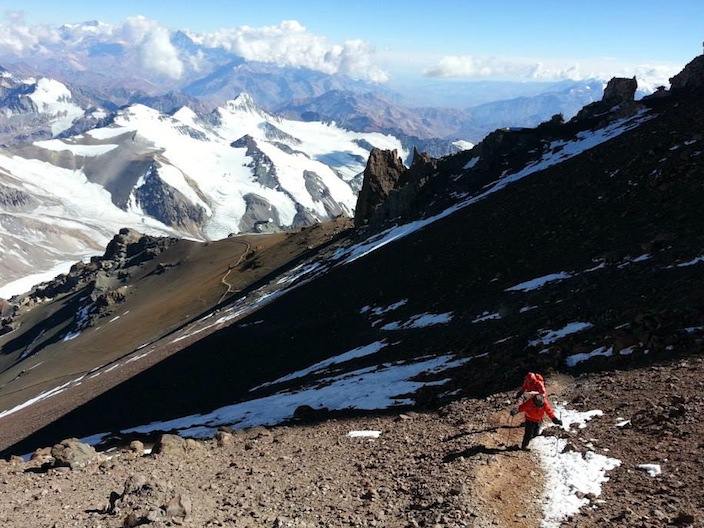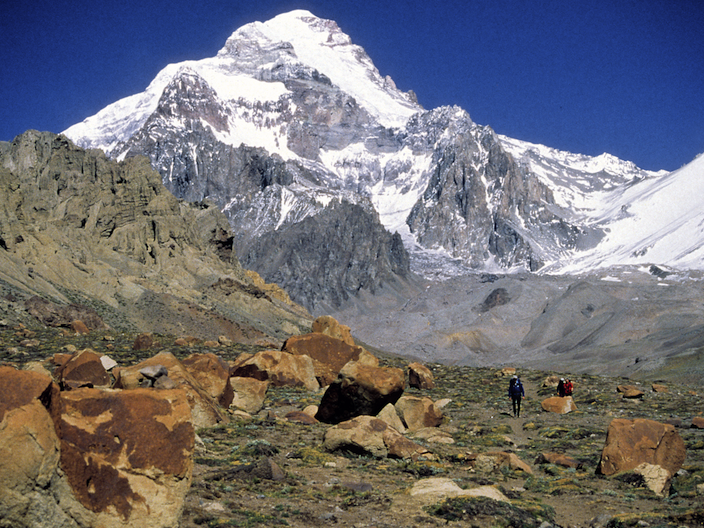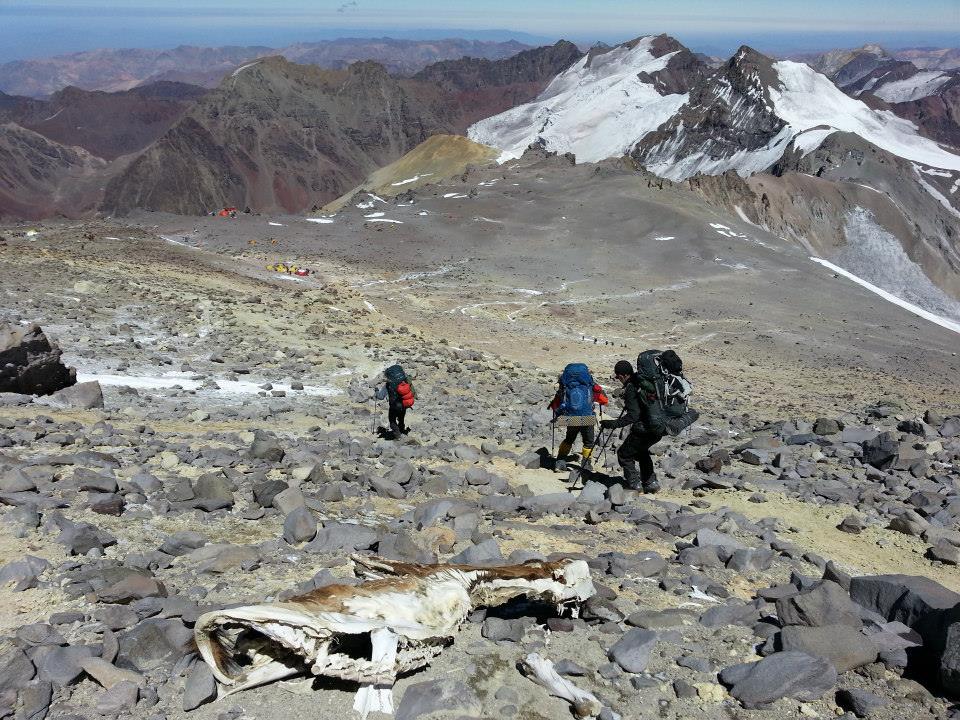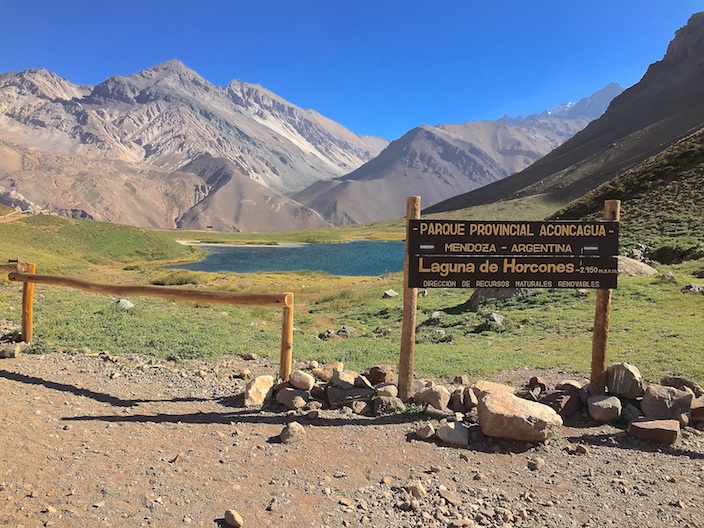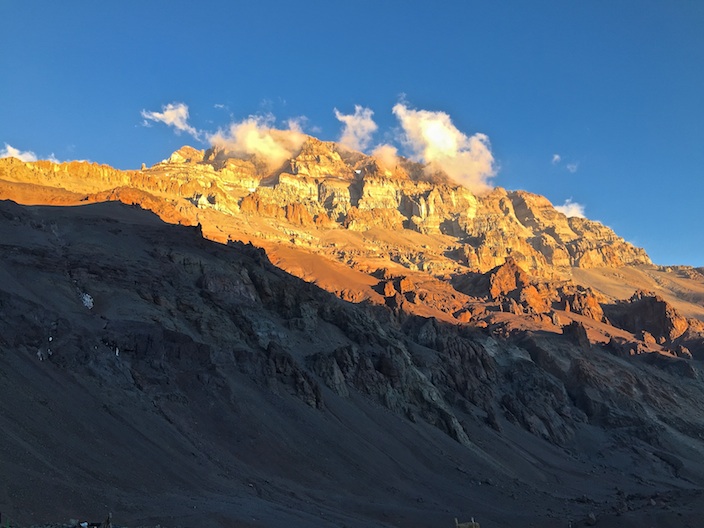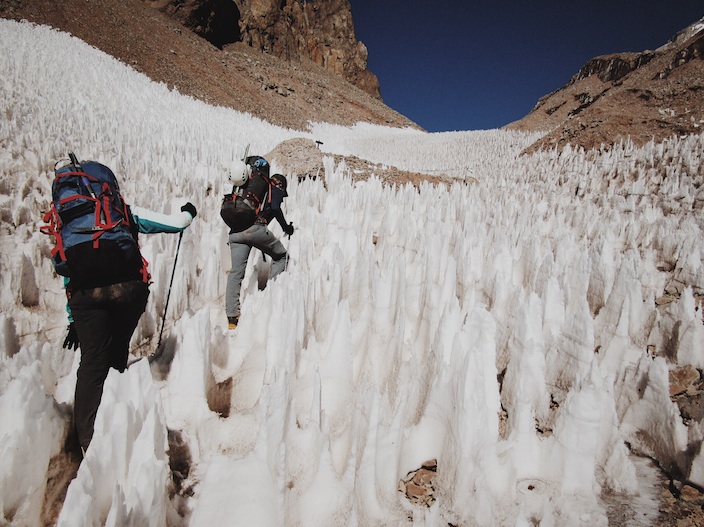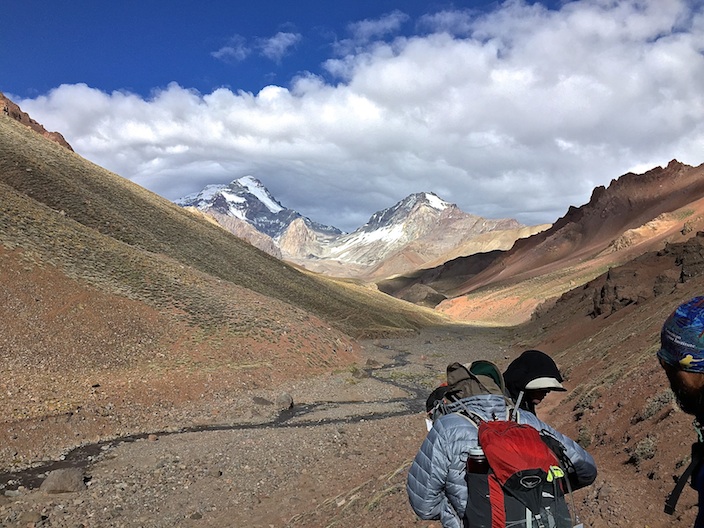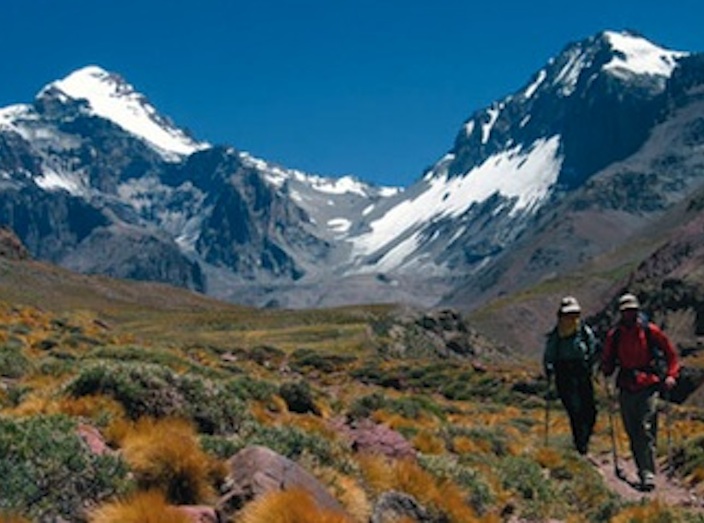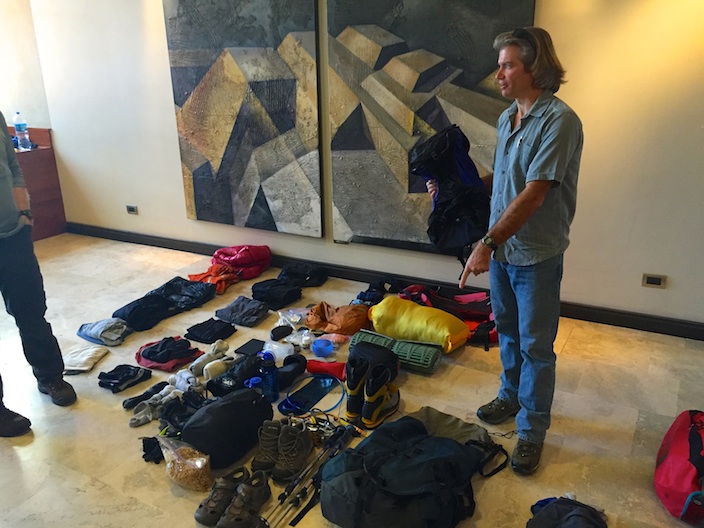Aconcagua Expedition - Upper Guanacos Traverse Overview Located near the western edge of Argentina's famous wine-producing province of Mendoza, Aconcagua rises to a height of almost 23,000 feet – the highest summit outside the Himalaya. American Alpine Institute was one of the first guide services to regularly climb Aconcagua. Beginning in the 1970s, Institute guides mounted expeditions throughout the region and pioneered routes, ticking off major ascents such as Aconcagua's 9,000-foot South Face.
Today, we use our deep experience to offer less commonly climbed routes that avoid the heavy traffic seen on much of the mountain. Our most popular route, the Guanacos Traverse, is an outstanding tour of the mountain that summits via the Guanacos and descends the normal route (Ruta de los Pioneros), returning via the Horcones Valley.
Expedition Highlights
Climb South America's highest mountain and one of the Seven Summits .
Enjoy light packs with mule support to base camp; optional porter assistance at high camps.
Ascend via the uncrowded Upper Guanacos Route, a stunning traverse and less traveled route.
Carefully crafted itinerary with an ascent philosophy maximizing chances for summit success.
Expedition leadership from AAI guides; with over 35 years of knowledge, we provide unparalleled mountain experiences.
The Mountain and the Routes
Aconcagua is in Argentina, just a few miles east of the Chilean border. It is about 225 air miles northeast of Santiago and 600 miles west of Buenos Aires. It was first climbed on January 14, 1897 by Swiss guide Matthias Zurbriggen, on a British expedition led by Edward Fitzgerald. The peak did not start receiving regular ascents until the 1960's.
All of our expeditions start in the Rio Vacas Valley and take a 3-day mule assisted trek to base camp at Plaza Argentina (13,780 feet or 4200 meters). This trek takes you up the beautiful Rio Vacas Valley. You start your trek in the desert terrain and end in the alpine environment.
Climbers make their return trip after a successful summit climb on Aconcagua's Upper Guanacos route. Jim Ledvinka
Although many refer to the Upper Guanacos as a trekking route, the route still can be snow covered and use of an ice axe and crampons my be required. Excellent physical conditioning and mental stamina for a big mountain expedition is required. The Upper Guanacos route enables you to climb up one route and descent the Route Normal, making a full traverse of the mountain by entering in the Rio Vacas Valley and exiting the Rio Horcones Valley.
The Polish Direct takes the same approach as the Upper Guanacos and at 17,200 feet ascends up to the base of the Polish Glacier at 19,200 feet. From here, the technical climbing begins and you ascend the most direct line up the Polish Glacier climbing 45-60 degree ice on the exposed Polish Glacier. This route is guided with a maximum of 2:1 climber to guide ratio.
Aconcagua Expedition - Upper Guanacos Traverse Routes and Itineraries Choose a Non-Technical or More Advanced Route The Upper Guanacos, is an excellent route that includes an ascending traverse of the spectacular upper peak on easy rock and occasional snow and a finish on the less technical, upper north side of the mountain. On the direct Polish Glacier route, called the Polish Direct, we tackle significantly exposed 45-degree ice climbing on the upper glacier. In recent years this route has involved belayed climbing on very hard ice, so we now only guide it at a maximum 2:1 climber-to-guide ratio.
Aconcagua's Polish Glacier descends from the summit diagonally right.
Join us for the Guancos Traverse if you have basic level alpine mountaineering skills and experience with cold-weather camping. Consider joining us for the Polish Direct route if you additionally are a solid snow and ice climber on 50-degree faces or steeper and have experience at or above 19,000 feet. Both routes offer a significant high altitude and physical challenge on a major expedition, and to have a good chance for success, you must be in excellent physical condition. The combined challenges of altitude, distance, cold weather, and varied terrain make this a great expeditionary climbing experience, and the aesthetics of both these two routes place them among the most sought after in the Western Hemisphere.
The Ascent To make our climb to Aconcagua's 22,842-foot summit, we establish three camps beyond our base. As part of our carefully structured program of acclimatization, we make double carries to each of the camps and allow for a full day of rest in the process of establishing each camp. Over AAI's three decades of history guiding Aconcagua, this pattern of ascent has allowed our expedition members to acclimatize thoroughly, to maintain their health and strength, and to maximize their chances for success on summit day. Other guide services place more camps for "more gradual acclimatization," but in fact inadvertently wear out climbers who end up with fewer rest days because they are moving camp so often. The Institute's unmatched success rate of 95.4% over a twenty-eight year period bears out the wisdom of this approach.
Preparing for the move up the mountain. Richard Riquelme
Leaving Base Camp on our climb to Camp 1, we move up a moraine to the glacier where we encounter rock-covered ice. Higher up we ascend another moraine that finishes with a 500-foot, 30-degree snow face. We often encounter huge nieve penitentes - pinnacles of ice sometimes up to seven feet high with ribs and troughs between them that are formed through uneven melting of the glacier. Perched at Camp 2 on a little plateau protected by a moraine at 15,500 feet, we can escape the periodically challenging furies of the local winds.
Our route to Camp 2 takes us to the Ameghino Col, and from that point we get our first views to the north, which include glaciated alpine peaks in a part of the Andean chain that has been rarely visited.
From the Col we work our way up to our highest camp at 19,900 feet. This spectacular camp is positioned perfectly for amazing views of the surrounding peaks as well as of the tiny tents below on the "Routa Normal."
The Climb to the Summit On the Upper Guanacos Traverse, we begin an ascending traverse soon after leaving camp. We avoid steep rock bands and carefully make our way on moderate terrain, primarily on rock and occasionally on snow. The views of the central Andes that stretch out to the north are quite spectacular as dawn approaches. Aconcagua's shoulders enlarge into sub-ranges as they fall away below us, giving an added appreciation of the immensity of the peak that we are climbing. We complete the rising traverse and join the standard route at about 20,500 feet on the North Face and continue up the rocky slopes to the airy 22,842-foot summit. The impressive views are a good match for our intense sense of accomplishment as reach the highest point in the Western Hemisphere.
Break high on the route. Richard Riquelme
When climbing the Polish Direct route, we begin the climb first on gentle ground, then on 35 to 40-degree terrain of mixed ice and wind-blown snow. At 21,000 feet we traverse to the south margin of the glacier over ice slopes and bulges ranging up to 45 degrees. At 22,000 feet we step onto the crest of the Southeast Ridge, and we suddenly gain a stunning view down Aconcagua's famous 9000-foot South Face. The steepness of the terrain quickly lessens, and we easily move up the spectacularly photogenic ridgeline. We pass a series of false summits, finally leaving the snow and ice to make an easy finish on rock to the 22,842-foot summit.
Our final day of climbing by either route takes us over some remarkable alpine terrain, and the intricacy of the routes combined with remarkable views create a fittingly dramatic finale to this major expeditionary climb.
Aconcagua Expedition - Upper Guanacos Traverse Details The AAI Approach
The Institute has enjoyed a very high rate of success on Aconcagua since its guides first began leading expeditions on the Polish Glacier in 1981. Almost every expedition led by the Institute has succeeded and helped most of its members reach their goal of getting to the summit.
AAI's success is due to a several factors. First, the expeditions are led by professional guides of the Institute, who do an outstanding job at the highest of international standards; they combine their great technical and judgmental skills with a dedication to their clients' goals and a willingness to work hard to achieve them. Over the years AAI expeditionary teams have helped many other guided and non-guided groups extricate themselves from serious trouble with storms, gear, and altitude illness.
Second, we ask clients who wish to join us to do a thorough job preparing for the expedition. We help each team member construct a suitable training program that will maximize their chance for success. And finally, we follow a carefully crafted itinerary that provides excellent acclimatization and that includes enough extra days to wait out storms while still leaving adequate time and resources to make a summit.
Prerequisites
Basic level alpine skills
Cold weather camping experience
Excellent physical condition
Flight Information
Your flight should be arranged so that you arrive in Mendoza on the first scheduled day of the trip. Departures can be made for the day after the last scheduled day of the expedition. Please contact our Travel Coordinator if you would like assistance with travel arrangements.
Dispatches
Every AAI expedition uses satellite communications equipment to provide daily updates on their approach and climb. Dispatches are posted on the Dispatches page of our website so family and friends can follow each climber's progress and get the flavor of the experience from the details describing the day's activity.
Aconcagua Expedition - Upper Guanacos Traverse Prices and Dates Sunset over the Andes from Camp Berlin at 19,500 ft.
2023/2024 Climbing Season
Dates TBD
We are staying in close contact with Argentine Consular Services in the US regarding when the country will reopen to tourism and when Aconcaugua will reopen for climbing. Their projected dates are changing regularly. Please call or email for an update.
Cost
Contact AAI for details.
Program Cost Inclusions and Exclusions
Inclusions:
AAI Mountain Guide services, instruction and leadership
Lodging (hotels and tents on a shared basis) for two nights in Mendoza and one in Penitentes split between the beginning and end of the expedition
Meals while on the mountain (minus snack and lunch food)
Group cooking and climbing equipment
Mule assistance to Plaza Argentina and from Plaza de Mulas
Transport from Mendoza to Penitentes and back
We use some freeze dried food in these programs; where weight is not a problem (helped greatly by our use of mules to haul supplies to base camp), we enjoy a varied and nutritious diet of fresh and dried foods.
Exclusions:
Aconcagua Expedition - Upper Guanacos Traverse Testimonials Success on the summit of Aconcagua!
"With three decades of expeditions, AAI is by far the most experienced guide service in the Andes."Adventure Travel
"Our guide was excellent - he really covered all the bases. He was extremely sensitive to where each member of the group was at, and encouraged us to be independent. He was very laid back, friendly, and had a great sense of humor, while at the same time being very safety conscious."Jim Ledvinka, Athens, GA
"Excellence in a guide service."Forbes Magazine
"What great, skilled, personable, physically strong climbing companions the guides were...absolutely top tier expedition leaders!"Richard Sorgun, Broomsfield, CO
Aconcagua Expedition - Upper Guanacos Traverse Related Courses
Program Finder
By Location
United States - Alaska
United States - Washington
United States - California
United States - Nevada
United States - Colorado
United States - Utah
Canada - British Columbia
South America - Argentina
South America - Bolivia
South America - Ecuador
South America - Patagonia
South America - Peru
Europe - Alps and Caucasus
Asia - Nepal and Tibet
Asia - Laos, Thailand, & Vietnam
Asia - China
Asia - Japan
Africa - Tanzania
Pacific and Antarctica
By Program Type
Instructional Courses
Group Summit Climbs
Expeditions
Skills Expeditions
Private Guided Programs
Treks, Tours, & Backpacking
Corporate Outings & Services
Government & Military
By Activity
Rock Climbing
Ice Climbing
Alpine Climbing
High-Altitude Climbing
Trekking and Backpacking
Skiing & Snowboarding
Guide Training & Rescue
Avalanche Training
Departure Month
Difficulty Level
Beginner
Moderate
Intermediate
Advanced
Very Advanced
x
